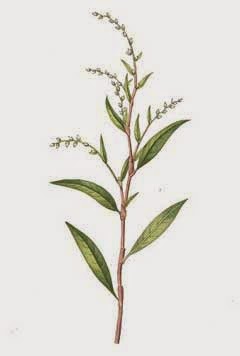Herb - Smartweed - Polygonum hydropiper
Herb - Smartweed
Latin name: Polygonum hydropiper
Photo Credit wikimedia.org
Synonyms: Persicaria fastigiatoramosa, Persicaria
hydropiper, Polygonum fastigiatoramosum, Polygonum maximowiczii
Family: Polygonaceae (Buckwheat Family)
Medicinal use of Smartweed:
Smartweed has a long history of herbal use, both in
Eastern and Western herbalism. It is not used very often, and is seen more as
a domestic remedy being valued especially for its astringent properties
which makes it useful in treating bleeding, skin problems, diarrhoea etc. The
leaves are anti-inflammatory, astringent, carminative, diaphoretic, diuretic,
emmenagogue, stimulant, stomachic, styptic. They contain rutin, which helps
strengthen fragile capillaries and thus helps prevent bleeding. Use with
caution. The seed is carminative, diuretic and stimulant. The whole plant,
either on its own or mixed with other herbs, is decocted and used in the
treatment of a wide range of ailments including diarrhoea, dyspepsia,
itching skin, excessive menstrual bleeding and haemorrhoids. A poultice of
the plant is used in treating swollen and inflamed areas. In Chinese tests, the
plant was ranked 20th in a survey of 250 potential antifertility drugs.
A homeopathic remedy is made from the leaves. It is used in the treatment
of piles, menstrual pains and other menstrual complaints.
Description of the plant:
Plant:
Annual
Height:
75 cm
(2 feet)
(2 feet)
Flovering:
July to
September
September
Habitat of the herb:
Shallow water in ponds, ditches etc and in wet places on
land.
Edible parts of Smartweed:
Leaves and stems - raw or cooked. They can also be made into
an acid peppery condiment. They are very hot. The leaves contain about 7.5%
protein, 1.9% fat, 8% carbohydrate, 2% ash. The leaves are said to contain
rutin. Seed - raw or cooked. It is rather small and fiddly to utilize. The seed
is used as a condiment - a pepper substitute. The sprouted seeds or
young seedlings can be used as a garnish or added to salads, they are
commonly sold in Japanese markets. They are very hot.
Other uses of the herb:
A yellow-gold dye is obtained from the stalks.
Propagation of Smartweed:
Seed - sow spring in a pot standing in water or in
situ. Germination is usually free and easy. When they are large enough to
handle, prick the seedlings out into individual pots and plant them out in the
summer if they have reached sufficient size. If not, overwinter them in
a cold frame and plant them out the following spring after the last
expected frosts.
Cultivation of the herb:
Shallow water in ponds, ditches etc and in wet places on
land.
Known hazards of Polygonum hydropiper:
Although no specific mention has been made for this species,
there have been reports that some members of this genus can cause
photosensitivity in susceptible people. Many species also contain oxalic acid
(the distinctive lemony flavour of sorrel) - whilst not toxic this substance
can bind up other minerals making them unavailable to the body and leading to
mineral deficiency. Having said that, a number of common foods such as
sorrel and rhubarb contain oxalic acid and the leaves of most members of this
genus are nutritious and beneficial to eat in moderate quantities. Cooking the
leaves will reduce their content of oxalic acid. People with a tendency to
rheumatism, arthritis, gout, kidney stones or hyperacidity should take especial
caution if including this plant in their diet since it can aggravate their
condition.
Plant information taken from the Plants For A Future.
Plant information taken from the Plants For A Future.




Comments
Post a Comment
Gidday there - It is so great to see you here. Thank you for coming along and visiting my humble little blog. I hope that you will stay and chat a while and let me know your thoughts or just share what is on your mind today. What we can share today can help someone else tomorrow. Be Kind, be Gentle and Love Life!